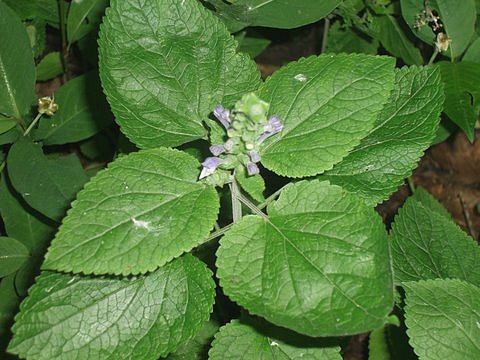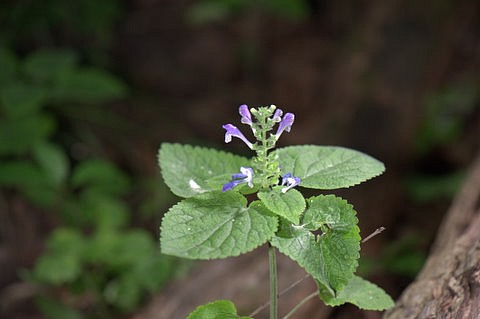
The central stem terminates in a raceme of flowers about 3-12" long. In addition, any upper lateral stems may produce smaller racemes of flowers. The racemes are narrow and usually only a few flowers are in bloom at the same time. Individual flowers are ½-1" long. Each flower consists of a blue-violet or purple corolla with 2 lips, a short tubular calyx with 2 lips, 4 inserted stamens, and a pistil with an inserted style. The corolla is much longer than the calyx. The corolla is narrow and tubular at its base, but becomes more wide and swollen towards its lips. The upper lip of the corolla consists of a protective hood, while the lower lip is larger, more rounded, and somewhat lobed. There is usually a large patch of white along the inside of the lower lip that is speckled blue-violet or purple. The calyx is about 1/8" (3 mm.) long, whitish green, and covered with glandular hairs. A protuberance occurs along the upper side of each calyx. The pedicels of the
Cultivation: The preference is dappled sunlight to medium shade, mesic conditions, and soil that contains loam, some calcareous sand, or rocky material (typically limestone). This wildflower is a good choice for shade gardens.
Range & Habitat: The native Heart-Leaved Skullcap is occasional throughout Illinois. Habitats include upland woodlands that are often rocky, bottomland woodlands, bluffs, woodland openings, shaded areas along cliffs, edges of limestone glades, and thickets. This wildflower is usually found in higher quality woodlands where the original ground flora is still intact.
Faunal Associations: The flowers are cross-pollinated by long-tongued bees, particularly bumblebees and Anthophorine bees (Anthophora spp.), which suck nectar and collect pollen. Short-tongued bees and Syrphid flies may also visit the flowers, but they are too small to be effective pollinators. Swallowtail butterflies and other butterflies occasionally visit the flowers, but they are also less effective at cross-pollination according to Robertson (1929). A few species of insects feed on the leaves of Heart-Leaved Skullcap and other skullcaps (Scutellaria spp.). These species include the skeletonizing leaf beetle Phyllobrotica limbata, Asphaera lustrans (Shiny Flea Beetle), larvae of Prochoreutis inflatella (Skullcap Skeletonizer Moth), and larvae of the moth Caloptilia scutellariella. The larvae of this last species are both blotch leaf-miners and leaf-folders. Because of its bitter taste and possible toxicity, mammalian herbivores rarely feed on the foliage.
Photographic Location: A floodplain woodland in Lake County, Illinois. The photographed plants are either Scutellaria ovata ovata or Scutellaria ovata bracteata. The photographs (Copyright © 2011) were taken by Paul Showers.

Comments: Unlike many other Scutellaria spp., this skullcap has mostly heart-shaped leaves with indented bases; sometimes the uppermost leaves have bases that are rounded, rather than indented. Across its range, Heart-Leaved Skullcap is highly variable and several subspecies have been recognized. In Illinois, three of these subspecies can be found: Scutellaria ovata ovata, Scutellaria ovata bracteata, and Scutellaria ovata rugosa. The first two subspecies occur throughout Illinois and they are distinguished by the size of the leafy bracts on their racemes: Scutellaria ovata ovata has leafy bracts that extend no farther than the calyces of the flowers, while Scutellaria ovata bracteata has leafy bracts that extend beyond the calyces of the flowers. The third subspecies, Scutellaria ovata rugosa, is only found in southern Illinois. It can be distinguished from the preceding subspecies by its small size (less than 1' tall) and small leaves (less than 1½" long).